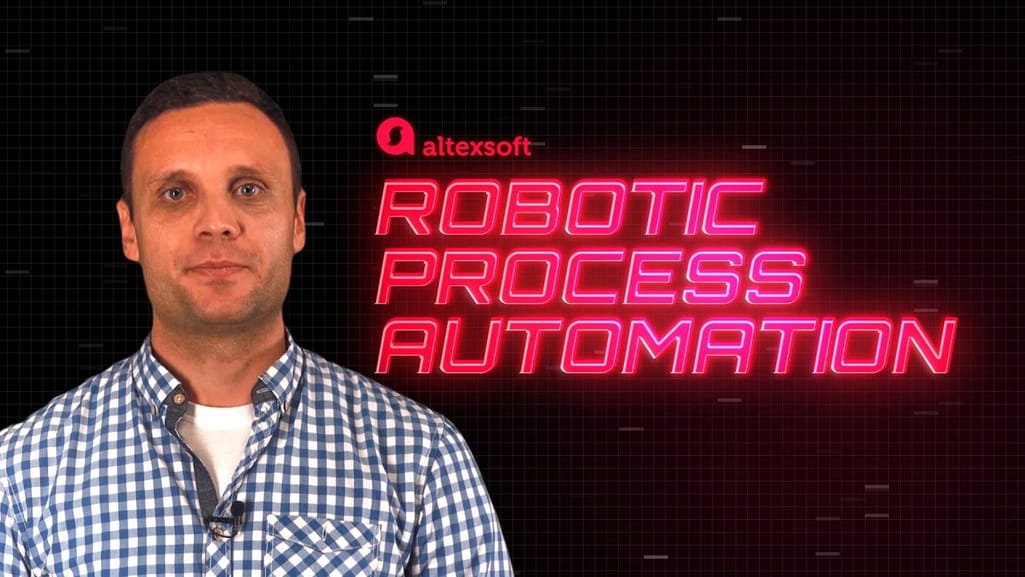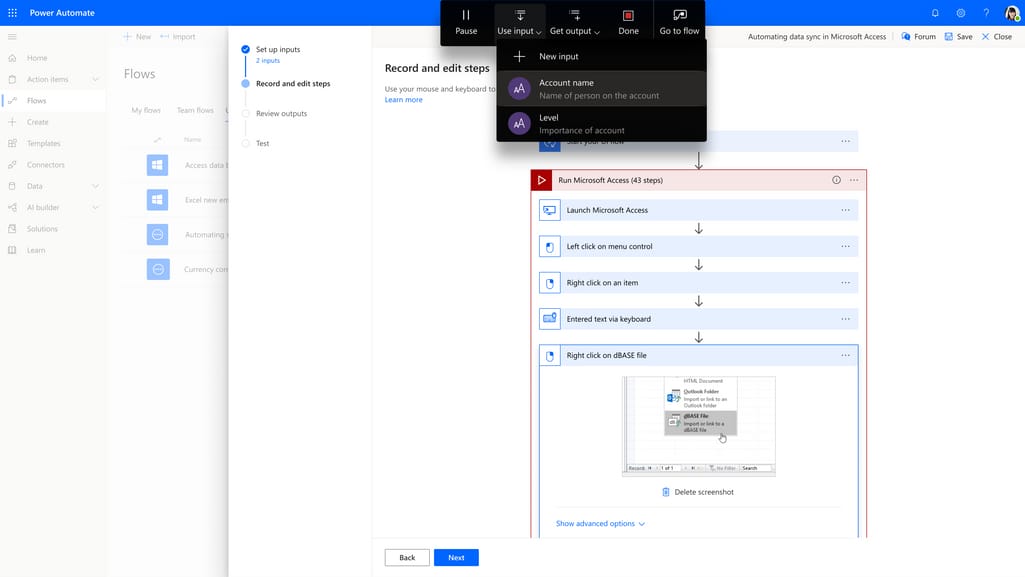No matter the size of a business, correctly assume some recurring processes keep it functioning. For the most part, these processes are high-volume repetitive tasks done manually. Think of back office operations such as order processing, request confirmation, approvals, and document fulfillment. Or front office tasks like answering phone calls, text messages, processing claims, and so on.
While this work is vital to keep a business running, mundane tasks are the slowest part of the overall workflow. In other words, it’s a bottleneck that causes money loss and hinders productivity. But if a task has a straightforward flow, why not automate it?
Robotic Process Automation or RPA is the name of an elegant solution for automating mundane business tasks. It has already become a buzzword, headlining Deloitte, Forbes, and McKinsey reports on RPA efficiency. And the trend is going further, as Gartner predicts nearly 69 percent of management tasks to be fully automated by 2024. Basic automation already covers thousands of standard business tasks out of the box, but there are also cognitive bots that promise to carry out more complex tasks. They use machine learning under the hood, and these types of RPA systems still require individual research and development.
So, that’s the foreword. This article is a good place to start learning what Robotic Process Automation is, how it works, and where it can be applied. Here, we’ll provide an overview of the technology types to give you the understanding of the tools and their capabilities. You may also watch our video:
While this work is vital to keep a business running, mundane tasks are the slowest part of the overall workflow. In other words, it’s a bottleneck that causes money loss and hinders productivity. But if a task has a straightforward flow, why not automate it?
Robotic Process Automation or RPA is the name of an elegant solution for automating mundane business tasks. It has already become a buzzword, headlining Deloitte, Forbes, and McKinsey reports on RPA efficiency. And the trend is going further, as Gartner predicts nearly 69 percent of management tasks to be fully automated by 2024. Basic automation already covers thousands of standard business tasks out of the box, but there are also cognitive bots that promise to carry out more complex tasks. They use machine learning under the hood, and these types of RPA systems still require individual research and development.
So, that’s the foreword. This article is a good place to start learning what Robotic Process Automation is, how it works, and where it can be applied. Here, we’ll provide an overview of the technology types to give you the understanding of the tools and their capabilities. You may also watch our video:


Robotic process automation in 10 minutes or less
What is Robotic Process Automation?
Robotic Process Automation describes a software program designed for mimicking human actions to complete repetitive business tasks. These programs have little in common with hardware robots but can act as an ordinary white-collar worker. RPA software can be configured to complete any type of task that has a clear sequence of actions to be reproduced:The task
Invoice processing often involves work with different file formats submitted by a client. These can be PDF files, MS Docs, TXT, or emails. The job of a worker is to collect required data from numerous invoices and transfer the data to a corporate financial database. Working with large amounts of disparate data makes this task tedious and error-prone.
Automation with RPA
A software robot can be configured to collect submitted invoices, read data fields across different file formats, and automatically transfer data from the sources to the financial database.

Power RPA by Microsoft, an example of a software interface for robot configuration
Source: cloudblogs.microsoft.com
In this simplest application, RPA will reproduce the given task 24/7 with close to zero error rate. It will require human intervention only if it has to be reprogrammed. By automating the manual side, human workers now can concentrate on their role-specific tasks. In this case — invoice processing.How RPA works in a nutshell
Without diving into tech details, RPA work can be explained in three simple steps.Training. After the robot is installed in your computer or server, it must receive some instructions to perform a task. These instructions, called training, 90 percent of the time, don’t require any programming skills or complex software configurations. RPA’s most popular training method is screen capture: Simply complete a task once for the bot to capture steps and file directories. After that, RPA is ready to reproduce these steps.
Operation. When the bot is trained, there are two possible ways it can operate. These are called attended and unattended RPA:
- Attended RPA software requires a user to trigger bots to start or stop completing their task. Such bots can also require minor changes to accurately perform the task when the flow changes, for example, a file destination change.
- Unattended RPA, as you’ve guessed, can operate without human involvement. Most often, these are bots installed on a virtual machine or a server, running in the background. Instead of manually launching your bot, unattended RPA uses a “trigger event” to complete a task.
The workflow may depend on the type of RPA bot you are using, as well as the complexity of the task. So let’s also look at what types of robots are out there and describe some tasks they can handle.
Main types of RPA: traditional and cognitive automation
There are two main types of robots available for businesses to automate different processes.Traditional RPA are the software programs used for simple tasks that don't require decision making or cognitive activity. These types of bots are also called rule-based systems as they require a set of rules on how to perform a task, where to log in, what data to collect, and where to transfer it. In general, robotic process automation refers to rule-based bots, which are good for simple tasks and scaling to thousands of automated processes.
Currently, traditional RPA covers nearly any business task off the shelf. Some providers like Datamatics offer over 800 use cases for RPA. That number indicates that the solutions market is mature and probably has a bot for your business case.
However, there are lots of limitations for this approach, as traditional RPA software can’t handle, say, human speech or adjust to changes in UI automatically. In that case, the second type of RPA can be used.
Cognitive Automation is the advanced form RPA capable of recognizing images, handwritten text, or understanding human speech. This type of RPA can be used to digitize documents, automate communication with clients, or analyze unstructured data.
Despite its powerful capabilities, cognitive robots have to be custom developed for a specific use case requiring a team that specializes in artificial intelligence and machine learning to implement cognitive robots for your process. Check our dedicated article on cognitive automation to learn more.
Now, let’s look at some common RPA applications and actual processes that can be automated.
RPA common use cases
As there are thousands of ready-made solutions for automating business processes, let’s divide them by industries. While this list won’t include even 5 percent of the overall use cases, it will help you with understanding the options.Retail banking
Bank account opening and closure. RPA can be used to automate the manual tasks related to opening and closing a client's bank accounts. For instance, a bot can automatically collect the client data sent in a digital format to create an order for bank account creation. The same goes for closing bank accounts that often involves manual cancelation of direct debits, transfers of funds, etc. The process can be automated by gathering input via a cancelation a form and passing it along to be processed by a human worker.Salary upload. Bots can initiate direct salary credits for corporate credit card holders or validate client data by the given parameters.
Loan processing and validation. Traditional RPA can support data gathering and compilation from various external and internal sources of the bank. As a result, RPA can produce a summary of data to enable bank workers to make decisions on the loan.
Insurance
We’ve already discussed different digital transformation opportunities in the insurance business, let’s have a look at it from the RPA standpoint.Regulatory compliance. The insurance business is one of the most regulated industries out there. RPA is often used to reduce human error in high volume tasks that require accuracy and strict adherence to regulations. For example, RPA can be set up to validate client information from multiple sources or it can be triggered to generate regulatory reports after data is updated.
Integration with legacy applications. Insurance industry still relies on the use of legacy systems for their business process management. With the lack of integration between different systems like ERP or Business Process Management (BPM) software navigation and data transfer becomes a burden. Robots are able to trigger user interfaces and APIs to automate exchange of data in formats that differ between the systems.
New policy issuance. Creating new policies and updating existing ones requires gathering and validating large amounts of data, creating payment IDs and matching them with the policy. RPA is often used to automate this part of the job.
Healthcare
Data ingestion. Healthcare deals with lots of paperwork, like patient forms on appointments. Transferring data from paper to the electronic health record system (EHRS) is a manual process that steals valuable time. Computer vision and its sibling technology, optical character recognition (OCR), are now used to intelligently scan written forms and blanks. Then digitized data is automatically loaded into the corresponding software systems.Schedule appointments. The bot can be set to send notifications to the patients on a schedule and synchronized with the other patient scheduling software. The COVID pandemic made this even more valuable, as many hospitals turned to telemedicine, handling a major portion of appointments online.
Send discharge instructions. Connected with the hospital’s discharge guidelines as a set of rules, the bot can also send prescription pickup or upcoming test notifications.
Remote patient monitoring. Remote care and monitoring patient health through electronic wearables involves exchanging large amounts of data. RPA has the potential to collect this data and send it to the physician, enabling the physician to efficiently track patient status directly from the application user interface.
eCommerce
Return processing. One of the most tedious tasks both for the customer and the eCommerce business is return processing, which involves checking inventory, billing information, customer data, and validating it through the process. Most of the time, this process is done manually. RPA can be integrated with a number of software systems to gather and check this data automatically.Customer support management. Using attended bots, customer support agents can trigger RPA to perform a vast number of tasks on data collection or some back office jobs like invoice/claims processing.
Product categorization. The bot can be trained to categorize and upload products, labeling them with the correct categories. As the process of manual inventory upload is always a pain for web store administrators, RPA can reduce the error rates and speed up the process significantly.
Human resources
Resumé analysis. Human resources and recruitment are burdened with manual data collection. One of the most intensive tasks is resumé screening. Most often, resumés contain semi-structured data that has similar properties and can be handled by the bot to analyze. Collecting these data and then forming a roster of candidates for the initial screening simplifies the recruiting process.New hire onboarding. The onboarding process often includes a number of manual tasks like creating accounts in the corporate systems, new email, inclusion in the email lists, personal information in the CRM, etc. Most of these tasks are performed manually and are a nuisance when a mistake is made. RPA can automate such procedures according to the company’s policies, either filling in the data on its own or validating it across corporate databases.
Offer letter management. RPA can also assist the HR professional by collecting and checking data for offer letter creation, sending, and tracking the status of it.
How to approach Robotic Process Automation
If you’re considering RPA software, but don’t know where to begin, here’s a list some basic steps to start with.1. Define and document repetitive processes
You have to select a business process that consists of clear steps and has simple objectives like “gather data and place it into a destination folder.” Make sure that these operations are streamlined and don’t require much human decision-making on the go to make them easier to automate.It’s better to shortlist several of those workflows and decide which of the shortlisted operations consume the least staff decision-making effort and, at the same time, bring the most value.
For instance, reviewing risk metrics or reporting on the most promising value streams may be the least likely candidates for automation while registering your customers and their data into multiple back office systems may be more successful options.
2. Define whether you need cognitive automation
Some areas may require cognitive automation, the tasks that involve computer vision (digitizing documents), speech recognition (transcribing customer service calls), natural language processing (responding to customer requests by phone or in a messenger), etc.Most traditional RPA systems struggle with such tasks. If that’s the case, it makes sense to search for a software provider with AI expertise, because cognitive bots require custom development and configuration for the exact process flow.
3. Look for an RPA solution
The market offers rich choices in terms of out-of-the-box solutions for traditional RPA tasks. So you need to run through some trusted ones, like Automation Anywhere, UiPath, Blue Prism, Pega, and find an RPA bot for your specific business case.4. Run a demo and scale
Starting on a small scale will give you understanding of the precise value RPA software can provide to your company. If the test was successful, you can scale the bots to automate other similar processes.Scaling will require training your operations teams and encouraging them to find more manual processes that can be further automated. Make sure that you’re tracking your progress and assess performance to iterate and improve your automation processes.
5. Estimate integration costs
Try to measure the return on investment after inquiring about the integration cost. Most providers will charge by the hour for a traditional RPA. So, you can calculate the profitability of the automation by comparing the increase in productivity and accuracy for a given task.Additionally, consider the cost of integrating RPA systems into your existing software if needed. Do you have APIs to integrate? Do you need some specific cognitive automation modules to support traditional RPA workflows? Try answering these questions before estimating final ROI and making a decision about full-scale adoption.
The bottom line
Looking at the variety of use cases, you can see the diversity of robotic process automation is clear. However, there are thousands more of them, sorted according to industry like accounting, real estate, travel, or education. So finding the right fit for RPA in your business shouldn’t be a problem since there is a solution for a majority of mundane tasks.Used on a large scale, RPA is capable of improving the general workflow of a company and providing impressive ROI. As the 2017 IBM study states, “Organizations that use RPA for accounts payable process invoices twice as fast as non-users, and they do so 43% faster and 40% less cost.”
Currently, there is a lot of buzz around RPA mistaken for AI and ML technologies. But the trends vividly show that the industry of RPA is slowly moving towards the integration of data-driven approaches for their software. The idea was clearly defined in IBM report on cognitive automation:
“Cognitive computing provides a new way of interacting with non-digital, upstream processes to collect and transcribe information in a manner that can then be leveraged downstream in the process by robots.”

